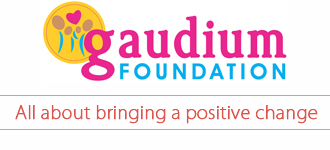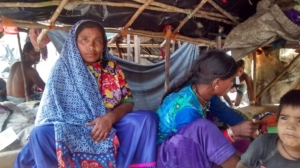Assam jumps on Modi bandwagon for safe motherhood
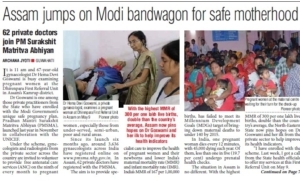
Guwahati: It is 11 am and 67-year-old gynaecologist Dr Hema Devi Goswami is busy examining pregnant women at the Dhirenpara First Referral Unit in Assam’s Kamrup district.
Dr Goswami is one among those private practitioners from the State who have enrolled with the Modi Government’s unique safe pregnancy plan, Pradhan Mantri Surakshit Matritva Abhiyan (PMSMA), launched last year in November in collaboration with the UNICEF.
Under the scheme, gynecologists and radiologists from the private sector across the country are invited to volunteer to provide free antenatal care services (ANC) on the ninth of every month to pregnant women , especially those from under-served, semi-urban, poor and rural areas.
Since its launch six months ago, around 3,636 gynaecologists across India have registered online on www.pmsma.nhp.gov.in. In Assam, 62 private doctors have registered with the PMSMA.
The aim is to provide specialist care to improve the health of pregnant women and their newborns and lower India’s maternal mortality rate (MMR) and infant mortality rate (IMR). India’s MMR of 167 per 1,00,000 births, has failed to meet its Millennium Development Goals (MDGs) target of bringing down maternal deaths to under 140 by 2015.
In India, one pregnant woman dies every 12 minutes, with 45,000 dying each year. Of them, less than one in five (19.7 per cent) undergo prenatal health checks.
The situation in Assam is no different. With the highest MMR of 300 per one lakh live births, double than the country’s average, the North-Eastern State now pins hopes on Dr Goswami and her ilk from the private sector to help improve its health indicators.
“I have enrolled with the scheme. Last week, I got a call from the State health officials to offer my services at this First Referral Unit on May 9.
It feels good to help these needy women,” said Dr Goswami. Commending the scheme, she hoped that her fraternity will come forward to dedicate at least one day a month to helping pregnant women in rural areas in the State, who often die in childbirth due to poor access to healthcare.
“Among pregnant women, anemia tops the list followed by irregular menstruation, hypertension, diabetes, multiple pregnancies, more than three miscarriages and congenital abnormalities,” she said, pointing out that the list is long.
For instance, Phulbano (19), who has come for a check-up for the first time from nearby Lokhara Village, is acutely anemic. Her first child died in the womb itself and now she’s taking iron tablets as advised by the ASHA worker accompanying her.
Like Phulbano, many others, belonging to the BPL category, have come from far off areas like Gualpada, Kamrup rural and Managldoi village for check-up.
Dr Pankaj Suthar, State maternal health consultant, UNICEF, is very optimistic. “The scheme is gradually picking up. So far, gynecologists have rendered services at Pandu First Referral Unit, Mahendra Mohan Choudhury Hospital, Panbazar, and Dhirenpara First Referral Unit, to name a few. We have been constantly writing to the private gynecologists.
“Since June 2016, we have covered 1.50 lakh pregnant women under the ANC services in our 288 health facilities in 32 districts. Our yearly target is 7.9 lakh pregnant women. We want to focus on high risk pregnancies to cut down mortality rate.
“Though ultra-sonography facilities are only in 69 First Referral Units, we have identified 288 sites for ANC services under PMSMA. If needed, help from other hospitals and private clinic is also taken.”
As part of the scheme, women are tested for anemia, blood pressure, high blood sugar (gestational diabetes), and other problems associated with pregnancy and provided free ultrasounds to track the health and development of the baby in the womb.
A Das, a gynecologist with the Pandu First Referral Unit stressed on creating awareness about the scheme among the targeted beneficiaries and holding regular meeting with the private doctors to sensitize them.
Dr JP Sharma, in-charge of the Dhirenpara First Referral Unit, echoed similar views saying Assam registers not only high MMR but also a very high IMR of 48 per one thousand live births as against 41 all India average. “High MMR is in certain belts like tea pockets and rough terrain where facilities are out of bound,” he said and hoped that PMSMA would give encouraging results.
Dr Sharma said that high-risk pregnant women are being identified and counseled about nutrition, family planning and overall birth readiness for newborns and postnatal care.
The programme has been initiated on the premises that if each and every pregnant woman in India is examined by a physician and appropriately investigated at least once during the PMSMA and then appropriately followed-up, it can help in reducing the number of maternal and neonatal deaths in the country.
Meet the community workers who convinced Muzaffarnagar’s Muslims to trust the polio vaccine
.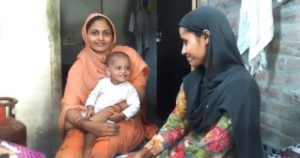
Once shoved, threatened and chased away, immunisation workers are now welcomed in villages in this Uttar Pradesh district.
At 5 am one day in October, 45-year-old Roshanara rose from her bed for her morning prayers. A few hours later, she began her daily rounds of Islampur, a village in the Khatauli tehsil of Muzaffarnagar in Uttar Pradesh. Roshanara is a Community Mobilisation Coordinator in Islampur and her job is to convince and remind families to vaccinate their children regularly.
Roshnara is spectacled and sunburnt and her wrinkles add a few years to her age, which is an asset in her cause. Armed with a detailed register of the vaccination histories of all children under five she makes her rounds taking special care to counsel those with newborns about the importance of giving their children “do boond” – the two drops of the polio vaccine.
“People believed they would become sterile if they took the drops,” said Roshanara, recalling the violent opposition she faced when she first began working in the community in 2003. She recalled an incident in a neighbourhood called Nayabadi where her team of seven had been given a target of clearing 10 XR cases, XR being code for those who resisted the oral polio vaccine.
“One woman pushed me against the edge of a cot when I asked if I could meet her children,” she said. “I threatened to call the police because she was behaving like this. That time I scared them into immunising their five children.”
Roshnara and other Community Mobilisation Coordinators in Muzaffarnagar say that their work is easier now, at least when it comes to convincing people to get vaccinated against polio.
In 1990, as part of an international campaign against polio, the Indian government committed itself to eradicating the disease by the year 2000 and instituted national and sub-national immunisation days supplemented by awareness campaigns. Uttar Pradesh was one state that reported pockets of resistance to the vaccination programme. In 2001, the region reported 80% of all cases in India and more polio cases than any country in the world. The statistics were accompanied by reports of communities, mostly Muslim and Dalit, resisting the oral polio vaccine.
A few kilometres away from Islampur at Chandbagh, a group of men met at Dr Mohammad Athar’s tiny clinic to discuss the immunisation programme. Mohammad Naem, an important opinion maker in his neighbourhood, was present amongst doctors, lawyers and maulanas. Naeem used to staunchly oppose vaccination.
“How else was I supposed to react?” Naem asked. “We didn’t have any basic health facilities and then suddenly these people showed up with these expensive medicines. Why were they handing these out for free? It is not like they were our relatives.”
Naem’s reservations reflect the perceptions amongst underserved communities that have had little faith in public health mechanisms. These communities associate free health services with family planning campaigns that they are suspicious of since they believe these target minority populations. Health workers and auxiliary nurse midwives administering oral polio vaccines also promote family planning and deliver contraceptives. Minority community suspicions were also stoked by remarks like those allegedly made by Varun Gandhi in 2009 about the “need to pick them [Muslims] up, one by one, and sterilise them”.
“People wondered why someone who wasn’t unwell should take medicine, especially when there were no immediate, visible results,” Mohommad Jahangir explained. “Many also wondered why the drops had to be taken repeatedly.”
Battling belief
The Community Mobilisation Coordinators also had to contend with matters of faith and the belief that paralysis was the result of a curse rather than a disease.
“The CMCs had a tough task because they had a target to meet, and they had to convince people to consume a substance which they were highly suspicious of,” said Jahangir.
Realising that illiteracy and lack of access to information were major hurdles, a consortium of organisations called the CORE group assisting the polio eradication programme initiated a communication strategy. This strategy aimed at creating awareness and altering parental attitudes in areas like Muzaffarnagar where children were susceptible to polio.
Funded by USAID, NGOs working in the space of community health spearheaded the polio project with Project Concern International taking the lead in Muzaffarnagar. Teams of Community Mobilisation Coordinators were formed with individuals from these communities. A group of about 17 coordinators, each of which kept records of 500 village households, would report to block mobilisation coordinators who in turn were answerable to a district mobilisation coordinator.
“They were trained to carry out basic Information Education and Communication activities like individual counseling, focused mothers’ meetings, how to maintain records and how to store and administer the vaccine,” said Tauquir Alam, district mobilisation coordinator at Khatauli.
On the ground, however, these women were left to their ingenuity and fortitude. With over sixteen years of experience, Roshanara has many cards up her sleeve. “In the simpler cases, we remind people that they have to take the drops when they go on a haj,” she said. “Sometimes, we take the drops ourselves to show that it is safe. There are also many who vaccinate their daughters but not their sons and then we remind them that it is our daughters who will give birth to sons. If it’s OK for the girls then it’s OK for the boys.”
Polio has also harder to reach nomadic communities that pass through Muzaffarnagar. (Photo: Neha Abraham)
Community Mobilisation Coordinators also have to establish trust with local families and this meant getting involved in other aspects of their lives. “I helped set up bank accounts, helped people procure ration cards,” said Roshnara. “Some weren’t receiving their pension, so I helped with that. If someone’s husband was beating them up, I helped them get justice. If there were health issues I accompanied people to the hospital, even if it was at 2 am.”
Roshnara also had to invest a lot of time and patience, especially with the XR cases. She once had to get acquainted with a couple who had five daughters and were refusing to get their newborn son immunised. “Over a period of three years I became their friend and not once did I mention polio,” she recalled. “This was possible because they weren’t in my area, and I was helping out with tough cases in other parts of Kathauli. Once I had the chance, I told her that my four sons had been vaccinated. I assured her that nothing would happen to her son if she did too.”
The very night that the boy got his polio drops, his parent observed a tremor in his leg. Roshnara rushed him to the hospital where the doctor told the boy’s parents that the child would be safe because he had been immunised.
“The boy is now 12 years old and I get so much of love and respect from that family,” said Roshnara.
Convincing settled communities to immunise their children is one tough battle, but there were also people harder to reach. At the dumping ground behind his shop in Sheikhpura, Iqbal the barber sees nomads make camp as they travel north from Barabanki. Iqbal saw some of the nomads affected by polio. He attended meetings with maulvis and doctors to learn about the polio vaccine and help convince members of the nomadic groups to get their children immunised.
“The nomads and many of my relatives had misconceptions,” he said. “The nomad women hid their children under their ghagras and Seema [the Community Mobilisation Coordinator] would have to pull them out. I told them to take the drops, nothing will happen.”
Iqbal the barber who has been awarded a certificate of appreciation by Project Concern International for his contribution to the immunisation efforts. (Photo: Neha Abraham)
“Winning the support of the maulanas was perhaps our biggest achievement,” said Hari Om, block mobilisation coordinator in charge of Kathauli. “A declaration from the local mosque has far more credibility than announcements on the radio, posters and hoardings. Maulvi sahib is very supportive and any declaration is only a phone call away.”
Naem, a resident of the more urban Chandbagh, also eventually agreed to let his 24 children, nieces and nephews get vaccinated. “It was the educated people in our community who were important,” he said. “We listened to them because we trusted them and if something went wrong we could also catch them.”
Hari Om is thankful that while earlier people would chase immunisation workers away with sticks and brooms they now inquire about when the teams will visit their areas next.
The goodwill towards health officials and vaccination teams was also confirmed in other ways as during the the 2013 riots, Hari Om recounted. He was among the team conducting a health camp on one of those turbulent days when suddenly the shops began to close and there was a curfew. It had also started to rain and the team, consisting entirely of Hindus, was getting anxious in the Muslim area.
“The doctor and Naem both went out, got drenched but they returned with a vehicle and dropped each of us home,” said Hari Om. “The gesture sent an important message to the CMCs and ANMs as well.”
This reporting project has been made possible partly by funding from New Venture Fund for Communications
UNICEF’s media workshop for raising awareness on health
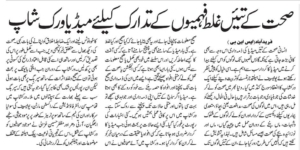
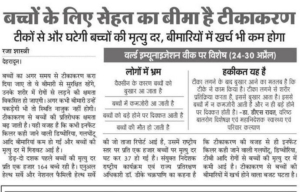
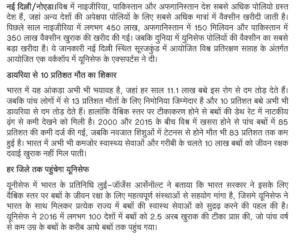
Timely immunization boosts a child’s immunity
Complete and timely immunization of children boosts their immunity and protects them against diseases. Vaccination has successfully eradicated some diseases and universal access to vaccine has led to a sharp reduction in the incidence of many vaccine-preventable fatal diseases like diphtheria and whooping cough. In India, the rise in vaccination coverage in past 10 years has reduced infant mortality rate from 164 to 37.
